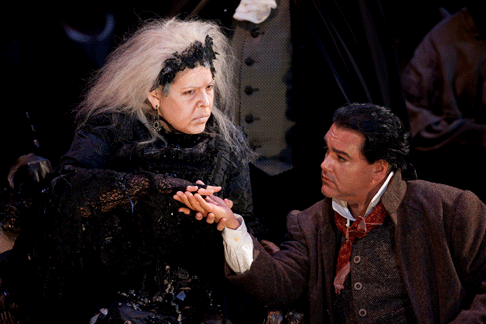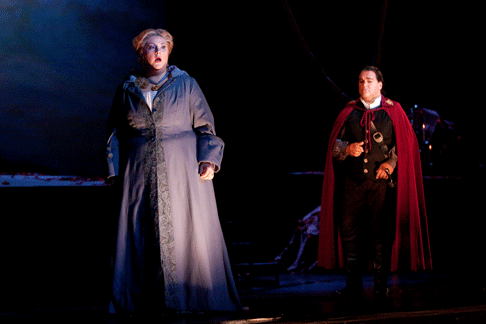19 Sep 2010
Un ballo in maschera at the Washington National Opera
Verdi’s 1859 hit Un ballo in maschera is an inspired choice to open an operatic season.

Verdi’s 1859 hit Un ballo in maschera is an inspired choice to open an operatic season.
Intrigue, jealousy, murder and mayhem amid the sparkle of a masked ball certainly provide all the ingredients necessary for a successful inaugural gala. Yet director James Robinson’s version of the Ballo that has opened Washington National Opera’s 2010-2011 season is for the most part a gloomy affair, deliberately bereft of pageantry and panache. The color palette is mostly silver, eggshell, and beige; the chorus is dressed in identical drab gray, their steel-gray masks completing the picture of cold, faceless mannequins. Perhaps the director wanted to set the passionate principals of the drama (who — both heroes and villains — are permitted color) in sharper relief against the bland complicity of the chorus that tends to break into sycophantic hymns of praise at every opportunity - a habit that both the conspirators of the story and quite a few members of the audience, in my experience, tend to find extremely irritating.
As is fashionable nowadays, the action in this Ballo has been moved back to the 18th-century Swedish court of Gustav III, Verdi’s original location, which spares an American audience from the torment of imagining the 17th-century Boston, MA, populated by the very un-pilgrim-like Renato and Riccardo. Otherwise, this production is almost entirely traditional, which seemed to suit most of the principals I saw on Tuesday, September 14th, quite well. The Italian imports (tenor Salvatore Licitra as Gustavo and baritone Luca Salsi as Renato, Count Anckarström) in particular tended to gravitate towards the footlights at every opportunity, singing to the audience rather than to each other. Soprano Tamara Wilson as Amelia also tended to limit her acting to an occasional turn of the head. Yet, especially toward the end of the opera, it somehow worked for her, lending her tragic character dignity and poise that, in her predicament, Amelia could certainly use.
The only person in the production whom I spied having any fun at all was Micaëla Oeste’s lovable page Oscar. Oeste’s light, pure tone and her fast, precise, flexible coloratura made short work of the difficult part. She also monopolized virtually all the stage business in this Masked Ball, dancing, flirting, and mischief-making her way through the performance and keeping alive the bubbly spirit of French comedy, which Verdi so carefully planted into his score and which the other performers occasionally seemed to have misplaced. The one exception was the tasty “laughing chorus” at the end of Act 2, led with a suave nonchalance by Kenneth Kellogg and Julien Robbins as Count Ribbing and Count Horn respectively.
One of the highlights of the evening was Salvatore Licitra, who will surely not lack for admirers in the DC area after his performance as Gustavo. Licitra’s is a powerful, metallic tenore di forza that we demand of our Dukes, Alfredos, and Radameses; it carried without strain, easily taking and holding the mandatory high Bs of Gustavo’s part. The singer was at his best in the bel canto strains of his cantabile arias, and as their prominence in his part increased in Acts 2 and 3, his performance soared, the famous grand duet with Amelia and the Act 3 romance Ma se m’è forza perderti garnering plenty of well-deserved applause. All that power, however, seems to come at the expense of flexibility, which made for a few awkward moments in Act 1, in which Gustavo must be at his comic best. While the opening La rivedrà nell’ estasi was lovely, Licitra’s solos in the stretta, Ogni cura si doni al diletto and particularly in the fabulous quintet, È scherzo od è follia in Act 1 Scene 2, lacked not only an articulate coloratura, but occasionally the basic pitch and rhythm, especially at the break-neck tempi chosen by the conductor, Licitra’s compatriot Daniele Callegari. The bright spot in that scene was the Russian mezzo-soprano Elena Manistina, who stole the show as the fortune-teller Ulrica (that is, Mam’zelle Arvidson, according to Verdi’s original cast list). Manistina’s deep, rich, darkly powerful voice carried easily, with perhaps only a little too much vibrato - an echo of the Moscow singing school that nurtured the singer, a former Operalia winner. Immediately impressive was the opening invocation; despite the distraction of her unfortunate costume and wig (a cross between Macbeth and The Witches of Eastwick), one could hear both the menace of Azucena and the mystery of the Pique Dame, Ms. Manistina’s two signature parts.
 Salvatore Licitra as King Gustavus III and Elena Manistina as Ulrica
Salvatore Licitra as King Gustavus III and Elena Manistina as Ulrica
As is so often the case, the overall impression of an opera production is either ruined or redeemed by the decisions of its design team, and the WNO’s Ballo was no exception (sets by Allen Moyer; original lighting by Duane Schuler; lighting by Jeff Bruckerhoff). The set for the fortune-telling scene, for instance, features the back panel of the palace ballroom, raised to hover diagonally over the stage, while Gustavo is forced to hide, in a most undignified fashion, behind a pile of left-over ballroom furniture. The choice of the ballroom’s fancy candelabra, partially covered with strips of cloth, somehow made to illuminate the Act 2 graveyard scene, is also rather puzzling. And alas, the pitiful sight of the choristers carrying their own chairs does make one reflect upon the depth of WNO’s budget woes. The “less is more” approach, however, works wonders in the opening scene of Act 3: set between the two panels - the floor and the much-too-low ceiling, with the sides draped in black, the austere design projects the oppressive and menacing atmosphere of the Anckarström household with spectacular power. Luca Salsi was equally spot-on with his Eri tu, one of Renato’s signature pieces and undoubtedly Salsi’s best contribution on Tuesday - his opening Alla vita che t’arride was shaky enough to make one wonder whether the part was too high for him. Like Salsi, Tamara Wilson’s Amelia grew on me as the evening progressed: her first act was unremarkable; the grand scena in Act 2 was better, although I was not entirely convinced by the duet; but the heart-breaking Morrò ma prima in grazia in Act 3 Scene 1, with its subtle mezzo voce, was truly memorable. That scene indeed proved one of the most potent in the production, if not for the orchestra - the timpani so loud and the brass so stunningly off-pitch, one could almost understand Amelia’s desire to end it all.
 Salvatore Licrita as King Gustavus III and Tamara Wilson as Amelia
Salvatore Licrita as King Gustavus III and Tamara Wilson as Amelia
In the final analysis, this WNO production of Un ballo in maschera, although uneven, is worth seeing, both for the highlights in the cast and for some powerful moments in direction and design. After all, the company is not spoiling us for choice this season, with only one other production — Salome — between now and March. Stay tuned!
Olga Haldey